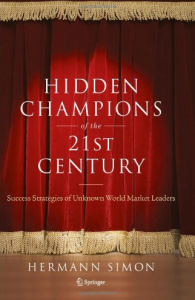Strategy Secrets of the Unknown Hidden Champions
 The Strategy Perspective
The Strategy Perspective
Book Review: Hidden Champions of the Twenty First Century: Success Strategies of Unknown Market Leaders by Hermann Simon
In a world where large corporations are often considered the custodians of contemporary management wisdom, it is refreshing and illuminating to re- read Hermann Simon’s Hidden Champions of the Twenty First Century.
Simon identified 450 Hidden Champions and studied 200 of them in detail. His findings, particularly on the topic of strategy, are well worth a look.
His definition of Hidden Champion was a company that was first, second, or third in their global market or first on its continent and had revenues below $4 billion as well as very low public awareness.
These companies had a tendency to be family owned and operated, located in regional areas, and a large percentage were based in Germany. They exhibited significant growth and were successful across most metrics.
The Hidden Champions of the Twenty First Century is an engaging read as Simon explains the lessons that he has gleaned from his study of these very successful corporations that most people have never heard of.
He explains that there are eight key lessons we can learn from these highly successful organisations and they as relevant today as when Simon commenced his research over a decade ago.
- Unsurprisingly the first lesson is all about leadership. These companies had dedicated leadership who set ambitious goals for the company to work towards.
- They were able to consistently attract and retain high performance employees and they put effort into coaching these people to their potential and beyond. Equally they dealt swiftly with non-performance and understood that not everyone is able to grow with the company.
- They developed depth in their value chain and had high vertical integration.
- They pursued ‘soft’ decentralisation wherever possible – provided that it better enabled them to deliver value to their customers. They avoided Ansoff’s ‘hard’ diversification (i.e. brand new products into brand new markets) as far too risky and not sufficiently integrated into their value proposition.
- They realised that ambitious goals can only be achieved by focusing your resources on the right activities.
- The were not afraid to globalize their business taking advantage of the enormous market opportunity that going global can deliver.
- They understood that innovation is the only effective long term means of succeeding in competition and invested a higher percentage of their earnings in R&D activities relative to their peers.
- They believed that closeness to customers almost always creates competitive advantage so they focused their efforts on delivering Customer Advantage not Competitive Advantage.
There is a counter-intuitive truth that companies tend to develop the discipline and focus to pursue strategic step changes during the harder economic times than when the going is good (and there is more money to invest in value creation.)
Given the ‘structural transition’ that we are currently experiencing, there has never been a better time to reflect on the strategic learnings of the Hidden Champions and consider their relevance in our current strategic conversations about the sustainability of our organisations.
